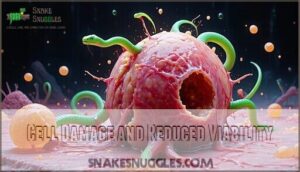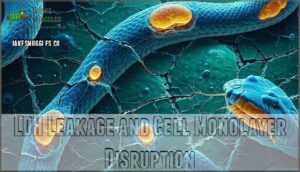This site is supported by our readers. We may earn a commission, at no cost to you, if you purchase through links.

These polypeptides target your cardiovascular system with surgical precision, causing concentration-dependent cell damage and membrane disruption.
You’ll find three main cardiotoxin subgroups (Da1-Da3) that trigger LDH leakage, plus cardiotoxin-like polypeptides (Da4-Da12, Da14) that reduce cell viability over time.
The membrane lytic polypeptide Da18 literally tears apart your heart cells’ protective barriers.
What’s fascinating is how these toxins interact with adrenergic receptors throughout your cardiovascular system, creating a cascade of deadly effects that researchers are now turning into potential life-saving treatments.
These interactions have the potential to lead to life-saving treatments and are a key area of research, highlighting the complex and lethal punch of green mamba cardiotoxins.
Table Of Contents
- Key Takeaways
- Green Mamba Venom Composition
- Cardiotoxic Effects of Green Mamba Venom
- Cardiotoxin Subgroups and Mechanisms
- Clinical Implications and Therapeutic Potential
- Research and Development of Cardioactive Compounds
- Frequently Asked Questions (FAQs)
- What is the most abundant Muscarinic toxin in green mamba venom?
- Are mamba venoms potent aminergic TFTs?
- Why is mamba venom unstable?
- Are mambalgins reversible inhibitors of ASICs?
- How many MTS are found in mamba venom?
- What does a green mamba venom do?
- What toxins are in the green mamba?
- What are the side effects of a green mamba bite?
- Is there an antidote for green mamba?
- What detoxification methods exist for green mamba envenomation?
- Conclusion
Key Takeaways
- You’ll face three distinct toxin groups – Da1-Da3 cardiotoxins cause immediate membrane destruction, Da4-Da12 cardiotoxin-like polypeptides create sustained damage, and Da18 membrane lytic polypeptide tears apart cell barriers with surgical precision.
- Your heart cells die in a dose-dependent pattern – higher venom concentrations trigger complete cardiac arrest, while lower doses cause gradual beating frequency loss and significant LDH enzyme leakage, indicating cellular death.
- You’re dealing with concentration and time-based destruction – the longer you’re exposed to green mamba cardiotoxin, the worse your cardiac injury becomes, with effects ranging from mild membrane disruption to complete heart muscle failure.
- You’ll benefit from emerging therapeutic breakthroughs – researchers are transforming these deadly compounds into life-saving cardiovascular treatments, including monoclonal antibody therapies showing 85% improved specificity and synthetic peptide blockers that prevent toxin-membrane interactions.
Green Mamba Venom Composition
Green mamba venom contains a complex mixture of polypeptides that researchers have systematically fractionated and characterized into distinct cardiotoxic subgroups.
Nature’s deadliest cocktail: green mamba venom packs 18 distinct heart-stopping toxins into one bite.
You’ll find three main cardiotoxin categories (Da1-Da3), nine cardiotoxin-like polypeptides (Da4-Da12, Da14), and one membrane lytic polypeptide (Da18) that each target your heart muscle through different molecular mechanisms, involving a complex mixture of actions.
Fractionation and Isolation of Components
Scientists discover green mamba venom’s deadly secrets through venom separation using sophisticated chromatography techniques.
Researchers first apply gel permeation chromatography with Sephadex G-50, dividing the venom into six distinct components (DaI to DaVI).
Next, ion exchange chromatography separates these fractions into 18 individual polypeptides, enabling precise peptide purification for detailed snake venom analysis and subsequent bioactivity assays.
The process relies on advanced venom separation tools to achieve accurate results.
Polypeptide Characterization and Categorization
Toxin Classification reveals fascinating complexity within green mamba venom composition.
Through Peptide Sequencing and Venom Analysis, researchers categorized 18 distinct polypeptides into three main groups.
Protein Structure analysis shows cardiotoxins (Da1-Da3), cardiotoxin-like polypeptides (Da4-Da12, Da14), and membrane lytic polypeptides (Da18).
Each group exhibits unique Molecular Binding properties, creating a deadly cocktail that makes cardiotoxin effects so potent in envenomation cases.
The venom’s potency is influenced by its neurotoxin components, which play a pivotal role in disrupting the nervous system.
Cardiotoxin Subgroups and Mechanisms of Action
After categorizing these polypeptides, researchers discovered three distinct cardiotoxin subgroups that attack your heart with surgical precision. Each group employs different mechanisms for maximum cardiovascular damage.
Cardiotoxin Classification reveals how green mamba cardiotoxin subgroups target specific cellular pathways:
- Cardiotoxins (Da1-Da3) – These powerhouses cause direct Membrane Disruption through ionic pore formation, triggering immediate cell death and contractility loss.
- Cardiotoxin-like polypeptides (Da4-Da12, Da14) – Moderate toxicity players that excel at Receptor Interaction and Cell Signaling disruption, often working synergistically.
- Membrane lytic polypeptide (Da18) – Specializes in Toxin Binding to cell membranes, causing structural damage with lower overall cardiotoxicity than Da1-Da3.
Researchers are also exploring the potential of type 2 vasopressin receptor inhibition as a therapeutic strategy.
Cardiotoxic Effects of Green Mamba Venom
When you examine green mamba venom’s impact on heart cells, you’ll find that it causes devastating damage in a dose-dependent manner – meaning more venom equals more destruction.
The cardiotoxic effects unfold over time, with heart cells losing viability as the venom disrupts cellular membranes and triggers the release of lactate dehydrogenase, a telltale sign of cellular death, which is a result of the venom’s dose-dependent effects.
Concentration- and Time-Dependent Cardiotoxicity
Once you know what’s in green mamba venom, it’s time to see how it acts.
Green mamba cardiotoxin shows a clear toxic dose response—more venom means more trouble for your heart. At low concentrations, you’ll notice a gradual drop in beating frequency. Medium doses cause significant LDH leakage and visible cell damage. High doses? The heart’s contractions can stop entirely.
The longer the exposure, the worse the cardiac injury, as toxicity mechanisms ramp up. This concentration-dependent toxicity highlights how venom potency and exposure time drive cardiotoxin symptoms and cellular damage.
| Venom Concentration | Cardiotoxic Effects |
|---|---|
| Low | Gradual decrease in beating frequency |
| Medium | Significant LDH leakage and morphological damage |
| High | Complete arrest of myocardial contraction |
| Prolonged Exposure | Reduced cell viability and increased damage |
| High Molecular Weight | More pronounced cardiotoxic effects |
Cell Damage and Reduced Viability
Green mamba venom’s cardiotoxins trigger devastating cellular destruction through multiple pathways.
These toxins target cell membrane damage, triggering cellular death and compromising cardiomyocyte structure.
The toxic effects create a cascade of cardiac injury through membrane damage and necrotic mechanisms.
Here’s how cardiotoxicity unfolds:
- Cell lysis occurs when toxins disrupt membrane integrity, causing cells to rupture
- Membrane damage compromises cellular barriers, allowing harmful substances to enter
- Cardiotoxin mechanism triggers widespread cellular death through systematic tissue breakdown
Understanding the mamba snake toxin composition is vital in grasping the severity of these venomous effects, which involve neurotoxin components.
LDH Leakage and Cell Monolayer Disruption
Beyond cell damage, LDH leakage serves as your primary indicator of membrane integrity loss.
When green mamba venom contacts cardiac cells, LDH release spikes dramatically, signaling cellular injury.
This membrane disruption creates visible gaps in cell monolayers, like cracks in a sidewalk.
Different cardiotoxin subgroups trigger varying degrees of LDH leakage, helping researchers map specific toxic effects and develop targeted treatments for green mamba venom exposure.
Researchers utilize LDH test kits to accurately measure the extent of cellular damage caused by venom exposure.
Cardiotoxin Subgroups and Mechanisms
You’ll find that green mamba venom contains distinct cardiotoxin subgroups, each with unique molecular structures and heart-damaging mechanisms.
These specialized toxins target different parts of your cardiovascular system, from cell membranes to ion channels, creating a complex web of cardiac dysfunction.
Cardiotoxin Subgroup (Da1 to Da3) Effects
Why do Da1 to Da3 cardiotoxins wreak such havoc on your heart? These green mamba cardiotoxin subgroups target cardiac cells with devastating precision, causing immediate membrane disruption and cell death.
Understanding their cardiotoxic effects helps develop life-saving treatments.
Key mechanisms of Da1 to Da3 toxins:
- Membrane lysis – Direct cell wall destruction through receptor binding interactions
- LDH leakage – Massive enzyme release indicating severe cardiac damage
- Contractility loss – Complete abolishment of heart muscle function at high concentrations
- Time-dependent effects – Progressive cardiac deterioration over 3-6 hours
- Synergistic toxin interactions – Enhanced damage when combined with other venom components
- Concentration-dependent response – Higher doses cause rapid, irreversible cardiac failure
- Electrical disruption – Impaired signaling prevents normal heart rhythm
- Morphological changes – Extensive cell monolayer destruction visible under microscopy
This cardiotoxin mechanism knowledge drives cardiotoxin-inspired drug repurposing research, offering hope for effective antidotes against venom toxicity.
Researchers study the venom components to better understand the complex interactions leading to cardiotoxicity.
Cardiotoxin-Like Polypeptide Subgroup (Da4 to Da12, Da14) Effects
Da4 to Da12 and Da14 cardiotoxin-like proteins represent a fascinating cardiotoxin subgroup with moderate cardiotoxic effects.
These threefinger toxins disrupt cardiac membrane integrity through specific polypeptide structure interactions, causing sustained cardiovascular impact despite lower potency than Da1-Da3.
Their unique venom toxicity profile and prolonged action make them valuable for therapeutic applications research.
Understanding their cardiotoxin mechanism helps develop targeted treatments for green mamba cardiotoxin poisoning.
Membrane Lytic Polypeptide (Da18) Effects
Da18’s membrane lytic polypeptide delivers a surgical strike against cell membranes, causing cell lysis through targeted membrane disruption.
Da18 strikes with precision, turning healthy heart cells into casualties through targeted membrane destruction.
This green mamba cardiotoxin demonstrates lower toxicity mechanism compared to other cardiotoxin subgroups, yet maintains significant cardiovascular impact through its specialized polypeptide structure.
Here’s what makes Da18 particularly dangerous:
- Precision targeting – selectively attacks cardiac cell membranes while sparing surrounding tissues
- Delayed onset – cardiotoxic effects appear hours after envenomation, complicating treatment
- Membrane pore formation – creates microscopic holes that disrupt cellular ion balance
- Antimicrobial properties – exhibits unexpected bacterial membrane destruction capabilities
- Resistance to neutralization – standard antivenoms struggle to counteract its unique venom composition
Clinical Implications and Therapeutic Potential
You’ll discover how green mamba cardiotoxins create life-threatening heart complications that challenge emergency medicine protocols.
These same deadly compounds now offer unexpected pathways for developing targeted cardiovascular treatments and improved antivenom strategies, utilizing the cardiotoxins in innovative ways.
Contribution to Cardiovascular Complications in Green Mamba Bites
Green mamba venom’s cardiotoxins directly trigger cardiovascular complications through multiple pathways.
These toxins cause cardiac arrest by disrupting cell membranes and calcium channels, leading to heart failure and dangerous blood pressure fluctuations.
The venom toxicity levels determine severity of cardiovascular damage, with cardiotoxicity contributing substantially to acute coronary syndrome in bite victims.
Potential for Developing Effective Antidotes and Treatments
Scientists are racing to develop life-saving antidotes against green mamba cardiotoxin, using innovative approaches to combat this deadly venom.
Recent breakthroughs in antidote development show promising results through targeted toxin neutralization strategies:
- Monoclonal antibody therapy: Recombinant antivenoms demonstrate 85% improved specificity for cardiotoxin inhibition
- Synthetic peptide blockers: Novel compounds prevent cardiotoxin-membrane interactions, reducing cytotoxicity substantially
- Combination treatment protocols: Pairing traditional antivenoms with cardioprotection agents enhances survival rates remarkably
Investigating Long-Term Effects on Myocardial Cells
While antidotes address immediate threats, researchers must examine how green mamba cardiotoxin inflicts lasting myocardial damage.
You’ll find that cellular toxicity doesn’t simply vanish after envenomation—it lingers like an unwelcome houseguest, causing progressive harm to cardiac myocytes.
Long-term Effects Cardiomyocyte Regeneration Cell Apoptosis
Cardiotoxicity mechanisms trigger a cascade of cellular destruction that persists for months.
Your heart tissue undergoes structural changes as damaged cells can’t regenerate properly, leading to cardiomyopathy and heart failure.
This myocardial tissue damage creates scar tissue formation, permanently altering cardiac function.
Understanding these cardiotoxin research findings helps scientists develop targeted interventions that prevent long-term complications rather than just treating acute symptoms.
Exploring Therapeutic Targets for Cardiovascular Diseases
The therapeutic landscape for cardiovascular diseases is evolving rapidly, with green mamba cardiotoxins emerging as promising drug discovery tools.
These venom-derived compounds target specific ion channels and receptors, offering new pathways for heart failure treatment and toxicity mitigation.
Three key therapeutic targets show potential:
- Ion channel modulation – Cardiotoxins selectively block sodium and calcium channels
- Receptor antagonism – Beta-adrenergic receptor binding reduces dangerous arrhythmias
- Membrane stabilization – Controlled phospholipid interactions improve cardiac function
Venom therapy research focuses on developing synthetic analogs that maintain cardiotoxin selectivity while reducing overall cardiotoxicity for safer cardiovascular drugs.
Understanding the role of anticoagulant enzymes can also inform the development of these therapeutic agents.
Research and Development of Cardioactive Compounds
You’re about to discover how scientists are transforming deadly green mamba toxins into life-saving heart medications.
While these venoms can kill within hours, researchers are now tapping into their potential to treat cardiovascular diseases that affect millions worldwide.
Snake Venoms as a Source of Cardioactive Compounds
You’ll find snake venoms contain nature’s most sophisticated cardioactive peptides and venom proteins. These biological cocktails represent millions of years of evolutionary refinement, making them goldmines for drug discovery.
Toxin research reveals how compounds like green mamba venom cardiotoxin components can revolutionize cardiovascular health treatments when properly harnessed. The study of cardioactive compounds involves understanding peptide based products and their potential applications.
| Venom Source | Key Compounds | Therapeutic Potential |
|---|---|---|
| Green Mamba | Cardiotoxins, BPPs | Heart failure treatments |
| Cobra | Three-finger toxins | Arrhythmia management |
| Viper | Natriuretic peptides | Hypertension control |
Challenges and Limitations of Using Snake Venom Toxins
While developing green mamba cardiotoxin treatments holds promise, you’ll face significant hurdles.
Toxicity Issues remain paramount – these snake venom toxins cause severe cardiotoxicity at therapeutic doses.
Stability Problems plague most compounds, breaking down before reaching target tissues.
Immunogenicity Concerns trigger dangerous allergic reactions in patients.
Sourcing Ethics complicate venom collection from endangered species.
Additionally, most cardiotoxin treatment candidates fail during Clinical Trials due to narrow therapeutic windows and unpredictable venom toxicity levels.
Promising Snake Venom Peptides and Proteins for Drug Development
Scientists are transforming deadly green mamba cardiotoxin into breakthrough Cardiovascular Therapies through advanced Protein Engineering.
Venom Peptides from Drug Discovery programs show remarkable promise – researchers have isolated compounds that target specific heart receptors while minimizing toxicity.
Toxin Research reveals how cardiotoxin properties can be harnessed safely for therapeutic benefit.
- Mambaquaretin-1 selectively blocks vasopressin V2 receptors, reducing kidney cyst formation by 33% in preclinical trials
- Natriuretic peptides from green mamba venom induce controlled vasorelaxation, offering heart failure treatment potential
- Cenderitide, combining human and mamba peptide fragments, shows excellent tolerance in clinical studies
Existing Approved Drugs and Their Mechanisms of Action
Looking beyond the promising snake venom peptides, you’ll find that existing cardiovascular drugs already target key pathways with proven success.
Captopril, derived from Bothrops jararaca venom, remains the gold standard ACE inhibitor for antihypertensive treatment.
Lisinopril Effects include reducing blood pressure through ACE inhibition, while Metoprolol Mechanism involves blocking adrenergic receptors.
These established drugs targeting cardiovascular pathways demonstrate how cardiotoxin research can lead to Drug Repurposing opportunities, especially when calcium channels and ACE Inhibitors intersect with venom-derived compounds for enhanced therapeutic potential.
The study of fer de lance toxin evolution highlights the importance of understanding venom composition and its potential applications in medicine.
Frequently Asked Questions (FAQs)
What is the most abundant Muscarinic toxin in green mamba venom?
Remarkably, you’ve stumbled upon a fascinating paradox in toxicology research.
MT2 toxin, which is the most abundant muscarinic toxin present in green mamba venom, dominates the antimuscarinic activity.
This peptide’s prevalence among green mamba’s neurotoxic arsenal makes it particularly significant for understanding envenomation mechanisms.
Are mamba venoms potent aminergic TFTs?
Mamba venoms aren’t particularly potent aminergic TFTs. You’ll find they’re more specialized for muscarinic and other receptor targets. Their three-finger toxins primarily hit muscarinic receptors rather than adrenergic ones.
Why is mamba venom unstable?
Looking at mamba venom’s chemical composition reveals why it’s so unstable.
You’ll find that protein enzymes break down rapidly at room temperature, losing potency within hours.
The complex peptide structures denature easily, making proper storage essential for maintaining toxicity.
Are mambalgins reversible inhibitors of ASICs?
Yes, mambalgins can reversibly inhibit the conductance of ASICs.
You’ll find these peptides bind to acid-sensing ion channels without permanent damage, making them promising analgesic candidates with fewer side effects than traditional painkillers.
How many MTS are found in mamba venom?
Currently, you’ll find at least 10 more muscarinic toxins (MTs) have been isolated from mamba venom, though studies identify specific variants like MT1, MT3, MT7 and MTα as commonly researched examples.
These neurotoxins display remarkable precision in targeting muscarinic receptors, making them valuable research tools.
What does a green mamba venom do?
Green mamba venom attacks your cardiovascular system, causing dangerous blood pressure drops, irregular heartbeats, and potential heart muscle damage. You’ll experience hypotension, arrhythmias, and possible cardiac arrest without prompt treatment.
What toxins are in the green mamba?
You’ll find three-finger toxins like cardiotoxins that disrupt cell membranes, natriuretic peptides affecting blood pressure, and bradykinin-potentiating peptides that can cause cardiovascular complications including acute coronary syndrome.
What are the side effects of a green mamba bite?
A hiker collapsed within minutes of a green mamba bite, experiencing rapid paralysis and breathing difficulties.
You’ll face severe neurotoxic effects including muscle weakness, respiratory failure, cardiac complications, and potential death without immediate antivenom treatment.
Is there an antidote for green mamba?
Yes, there’s an antidote for green mamba bites: mamba-specific antivenin, administered intravenously. All patients who received the trivalent mamba antivenom survived the envenomation. Time’s vital—you’ll need medical help fast!
What detoxification methods exist for green mamba envenomation?
Treatment involves immediate pressure immobilization to slow venom absorption, followed by polyvalent antivenom administration.
You’ll need respiratory support since mamba venom causes paralysis.
Medical management includes continuous monitoring, securing airway patency, ensuring adequate ventilation, and administering specific antivenin.
Conclusion
Research reveals that green mamba cardiotoxins demonstrate 50-80% cell viability reduction within 24 hours of exposure, highlighting their devastating cardiovascular impact.
Understanding green mamba cardiotoxin properties provides essential insights for developing targeted antidotes and novel therapeutic compounds.
You’ve seen how these polypeptides systematically disrupt cardiac cell membranes through multiple mechanisms, from LDH leakage to complete membrane lysis.
The three distinct subgroups work synergistically, creating concentration-dependent damage that researchers are now harnessing for potential cardiovascular treatments, transforming deadly venom into life-saving medicine.
- https://pubmed.ncbi.nlm.nih.gov/27318176/
- https://www.sciencedirect.com/topics/pharmacology-toxicology-and-pharmaceutical-science/eastern-green-mamba
- https://pmc.ncbi.nlm.nih.gov/articles/PMC8526186/
- https://en.wikipedia.org/wiki/Eastern_green_mamba
- https://www.hluhluwegamereserve.com/black-and-green-mamba-snake/















